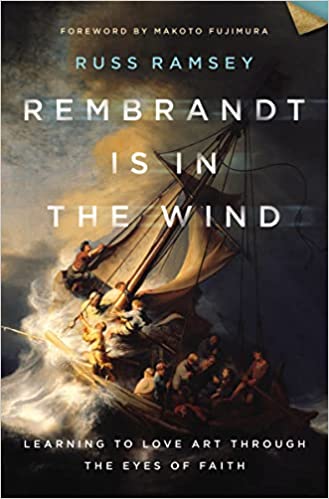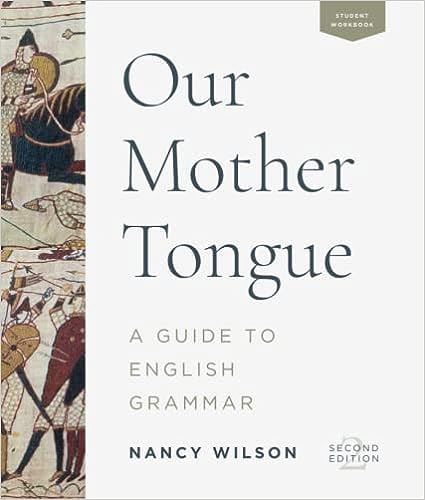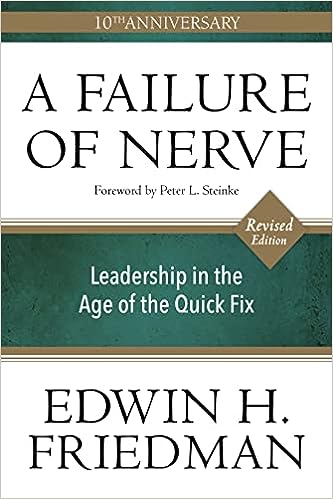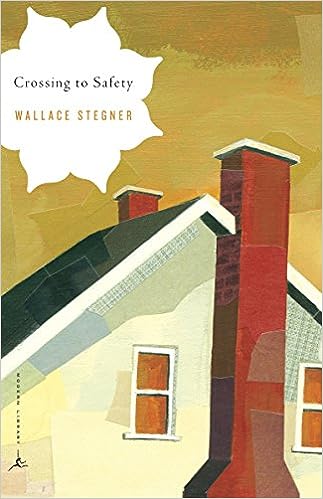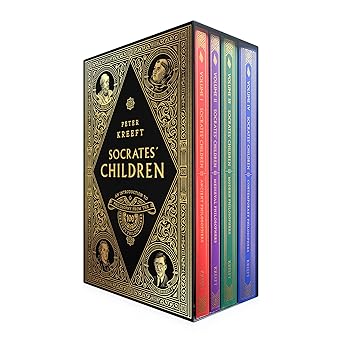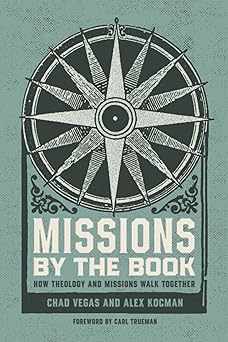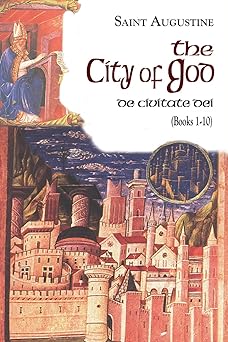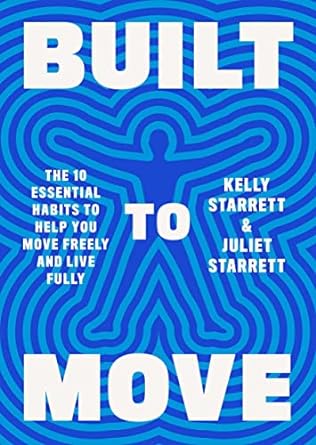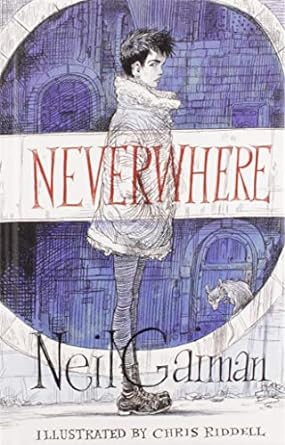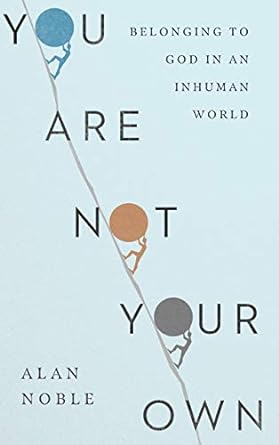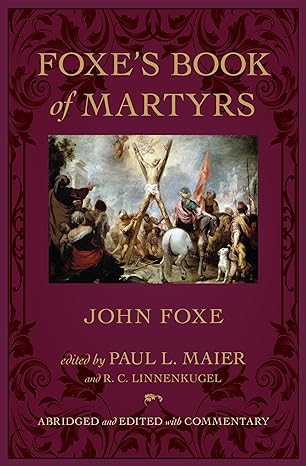Rembrandt is in the Wind: Learning to Love Art through the Eyes of Faith
Did you know Vincent van Gogh sold only one painting during his lifetime and that during the last three months of his life he completed an average of one painting every day?
Did you know that Michelangelo's David is covered in a dusting of human skin?
Did you know Caravaggio murdered several people while he was painting some of the most glorious paintings of biblical scenes the world has ever known?
Rembrandt Is in the Wind by Russ Ramsey is an invitation to discover some of the world's most celebrated artists and works, while presenting the gospel of Christ in a way that speaks to the struggles and longings common to the human experience.
The book is part art history, part biblical study, part philosophy, and part analysis of the human experience; but it's all story. The lives of the artists in this book illustrate the struggle of living in this world and point to the beauty of the redemption available to us in Christ. Each story is different. Some conclude with resounding triumph while others end in struggle. But all of them raise important questions about humanity's hunger and capacity for glory, and all of them teach us to love and see beauty.
More info →Our Mother Tongue: A Guide to English Grammar
The importance of the spoken and written word in Christian culture cannot be overestimated. In this easy-to-follow, step-by-step workbook, Nancy Wilson surveys the major concepts in English grammar for beginners at the upper elementary and junior high level (or even older English speakers seeking a brush-up!). Our Mother Tongue dishes up examples and exercises that go beyond the stereotypical, contrived sentences serving merely to illustrate a point, and relies on selections from Scripture and great English literature to instruct students with regard to content, style, and structure. In addition to a helpful format that highlights key definitions, punctuation issues, and important concepts, short historical sidebars tell the fascinating story of the development of English. Our Mother Tongue also teaches the traditional and extremely helpful exercise of sentence diagramming, which trains students to quickly analyze the purpose and structure of any sentence. The grammatical explanations, the logic of diagrams, and the rhetoric of her examples blend with complementary emphases to create an important classical and Christian text. Daily lesson plans included!
More info →A Failure of Nerve: Leadership in the Age of the Quick Fix
An invitation and guide for leaders “to cast a courageous and imaginative vision, to lead resiliently, and to be present and steady in times of deep anxiety.”
Ed Friedman’s genius was to see the individual in the family in the larger group, bringing the wisdom of his experience as a therapist and rabbi to the field of organizational leadership.
A timeless bestseller, A Failure of Nerve still astonishes in this new edition with its relevance and continues to transform the lives of leaders everywhere―business, church, family, schools―as it has for more than 20 years:
- Offers prescient guide to leadership in the age of “quick fix.”
- Provides ways to recognize and address organizational dysfunction.
- Emphasizes “strength over pathology” in these anxious times.
“The age that is upon us requires differentiated leadership that is willing to rise above the anxiety of the masses. We need leaders who will have the ‘capacity to understand and deal effectively’ with the hive mind that is us. This is, in Friedman's words, ‘the key to the kingdom.’ I am grateful for this accessible new edition.”
―C. Andrew Doyle, Bishop, Episcopal Diocese of Texas
Crossing to Safety
Called a “magnificently crafted story . . . brimming with wisdom” by Howard Frank Mosher in The Washington Post Book World, Crossing to Safety has, since its publication in 1987, established itself as one of the greatest and most cherished American novels of the twentieth century. Tracing the lives, loves, and aspirations of two couples who move between Vermont and Wisconsin, it is a work of quiet majesty, deep compassion, and powerful insight into the alchemy of friendship and marriage.
More info →Socrates’ Children Box Set
Peter Kreeft, esteemed philosophy professor and author of over eighty books, has taught college philosophy for sixty years. Throughout those decades, he yearned for a beginner's philosophy text that was clear, accessible, enjoyable, and exciting (perhaps even funny). Finding none that met those criteria, he eventually decided to write it himself.
In this four-volume series, Kreeft delivers, with his characteristic wit and clarity, an introduction to philosophy via the hundred greatest philosophers of all time. Socrates’ Children examines the big ideas of four major eras―ancient, medieval, modern, and contemporary―and immerses the reader in the “great conversation,” the ongoing dialogue among the great thinkers of history, including the most influential philosopher of all: Socrates, the father of Western philosophy.
Volume I: Ancient Philosophers investigates the foundations of philosophy laid by the ancient sages, Greeks, and Romans and introduces the philosophers who asked the first great philosophical questions―about good and evil; truth and falsehood; wisdom, beauty, and love; and the self, the world, and God.
Volume II: Medieval Philosophers studies the transformation of philosophy that came about due to an unprecedented figure―Jesus Christ―and considers the philosophers of the great monotheistic religions of Judaism, Christianity, and Islam as they sought to marry the Greek philosophical tradition with divine revelation.
Volume III: Modern Philosophers explores a philosophical world caught up in the spirit of the Enlightenment―a time of both scientific discovery and social upheaval―and examines the philosophers who sought above all to answer the great questions of epistemology and politics: What is knowledge? How can we be certain? What is society? What is its greatest good?
Volume IV: Contemporary Philosophers surveys the great philosophers of the nineteenth and twentieth centuries, an era of the splintering of philosophy into a variety of schools. Some, disconnected from the past, rebelled against the very endeavor of philosophy, but others, seeking to revitalize ancient conversations, returned to and renewed the deepest questions of meaning, happiness, and the human person.
More info →Missions By the Book: How Theology and Missions Walk Together
Across the church, there is a rift between theology and missions. Bad theology produces bad missions, and bad missions fuels bad theology.
We wrongly think that we must choose between making a global impact and thinking deeply about the things of God. But the relationship between theology and missions is symbiotic—one cannot exist without the other. They walk hand-in-hand.
More info →The City of God (The Works of Saint Augustine: A Translation for the 21st Century)
Along with his Confessions, The City of God is undoubtedly St. Augustine's most influential work. Following Augustine's critique of the Roman religious, political, and intellectual tradition in Books 1-10, Books 11-22 set out his great vision of the origins, the histories, and the ultimate destinies of the two cities: the earthly city, rooted in love of self as expressed in the pride and lust for domination that shatter human society, and the heavenly city, rooted in love of God as expressed in the humility and yearning for the supreme good that unite humanity in a just social order. For all those who are interested in the greatest classics of Christian antiquity, The City of God is indispensable.
This long-awaited translation by William Babcock is published in two volumes, with an introduction and annotation that make Augustine's monumental work approachable. The INDEX for Books 1-22 (both volumes of The City of God) is contained in this volume.
More info →Albion’s Seed: Four British Folkways in America
This fascinating book is the first volume in a projected cultural history of the United States, from the earliest English settlements to our own time. It is a history of American folkways as they have changed through time, and it argues a thesis about the importance for the United States of having been British in its cultural origins.
More info →Built to Move: The Ten Essential Habits to Help You Move Freely and Live Fully
After decades spent working with pro-athletes, Olympians, and Navy Seals, mobility pioneers Kelly and Juliet Starrett began thinking about the physical well-being of the rest of us. What makes a durable human? How do we continue to feel great and function well as we age? And how do we counteract the effects of technology-dependence, sedentary living, and other modern ways of life on our body’s natural need for activity?
The answers lie in an easy-to-use formula for basic mobility maintenance: 10 tests + 10 physical practices = 10 ways to make your body work better
The book offers:
- Easy mobilization practices to increase range of motion and avoid injury
- Intuitive ways to integrate more movement into your daily life and escape sedentary habits
- No-fuss guidelines for improving nutrition and sleep
- Basic breathing practices to manage stress and pain
- Quick and simple assessments to gauge progress and what needs improvement
- Tips and perspectives on healthy aging
It’s full of foundational wisdom for everyone from beginners to professional athletes and everyone in between. Built to Move introduces readers to a set of simple principles and practices that are undemanding enough to work into any busy schedule, lead to greater ease of movement, better health, and a happier life doing whatever it is you love to do—and want to continue doing as long as you live. This book is your game plan for the long game.
More info →Neverwhere
Published in 1997, Neil Gaiman’s first novel, Neverwhere, heralded the arrival of a major talent. Over the years, various versions have been produced around the world. In 2016, this gorgeously illustrated edition of the novel was released in the UK. It is now available here, and features strikingly atmospheric, painstakingly detailed black-and-white line art by Chris Riddell, one of Gaiman’s favorite artistic interpreters of his work.
Richard Mayhew is a young London businessman with a good heart whose life is changed forever when he stops to help a bleeding girl—an act of kindness that plunges him into a world he never dreamed existed. Slipping through the cracks of reality, Richard lands in Neverwhere—a London of shadows and darkness, monsters and saints, murderers and angels that exists entirely in a subterranean labyrinth. Neverwhere is home to Door, the mysterious girl Richard helped in the London Above. Here in Neverwhere, Door is a powerful noblewoman who has vowed to find the evil agent of her family’s slaughter and thwart the destruction of this strange underworld kingdom. If Richard is ever to return to his former life and home, he must join Lady Door’s quest to save her world—and may well die trying.
More info →You Are Not Your Own: Belonging to God in an Inhuman World
This is the fundamental assumption of modern life. And if we are our own, then it's up to us to forge our own identities and to make our lives significant. But while that may sound empowering, it turns out to be a crushing responsibility―one that never actually delivers on its promise of a free and fulfilled life, but instead leaves us burned out, depressed, anxious, and alone. This phenomenon is mapped out onto the very structures of our society, and helps explain our society's underlying disorder.
But the Christian gospel offers a strikingly different vision. As the Heidelberg Catechism puts it, "I am not my own, but belong with body and soul, both in life and in death, to my faithful Savior Jesus Christ." In You Are Not Your Own, Alan Noble explores how this simple truth reframes the way we understand ourselves, our families, our society, and God. Contrasting these two visions of life, he invites us past the sickness of contemporary life into a better understanding of who we are and to whom we belong.
More info →Foxe’s Book of Martyrs
An updated and modernized edition of the unparalleled classic with resurgent relevance for the twenty-first century
Foxe's Book of Martyrs is one of the most influential and well-known books in history, as well as one of the top-sellers of the past, right up there with the Bible itself. Immensely popular in Foxe's own sixteenth century, its influence has been felt throughout literature. Copies of the original text (Acts and Monuments) were chained beside the Bible in churches of England, and even sailed with English pirates.
This was not a book designed to comfort, but instead to present the truth of the persecution faced by Protestant Christians in hostile environments. The inscription from the 1563 edition--now commonly known as Foxe's Book of Martyrs--indicates the gravity of the task: "[In] latter and perilous days . . . the great persecutions and horrible troubles . . . [are here] gathered and collected according to true copies and writings . . . of the parties themselves that suffered." Foxe was committed to commemorating the ultimate sacrifice of those who gave their lives for the sake of their faith.
Paul L. Maier brings his exceptional mind for history to bear on Foxe's work in this new edition. While abridgement of the original 2,100 pages was necessary, Maier does include every martyr, and text was changed only where modern readers may not readily understand the original archaic wording.
John Foxe (1516-1587) was an academic and zealous student of the Scriptures, leading to his persecution as a Protestant by the Catholic rulers of his day. Beyond his work in pastoral ministry, Foxe continued to work on his martyrology until his death.
More info →
